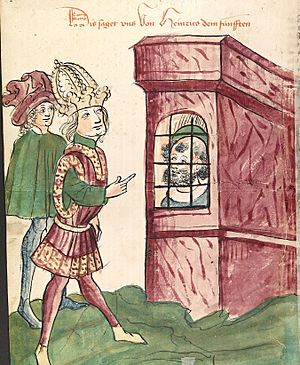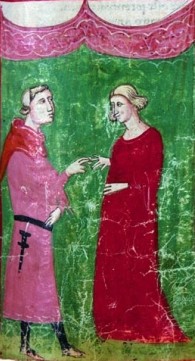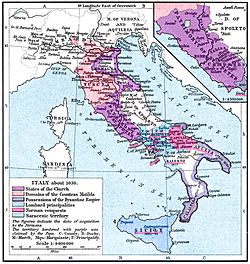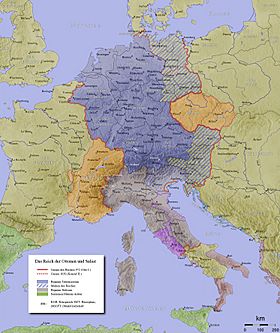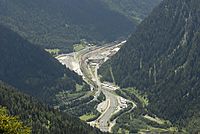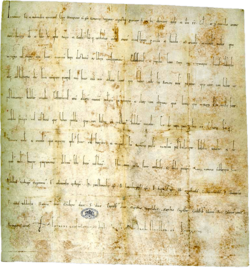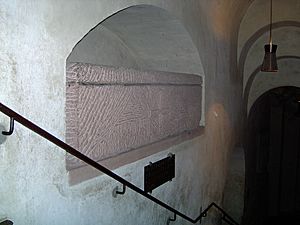Henry V, Holy Roman Emperor facts for kids
Quick facts for kids Henry V |
|
|---|---|
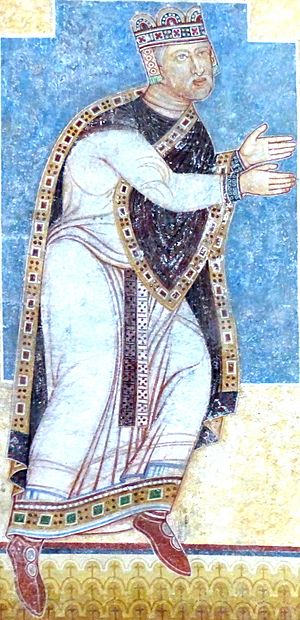
Henry V depicted in a Romanesque fresco, Prüfening Abbey, c. 1130
|
|
| Holy Roman Emperor | |
| Reign | 13 April 1111 – 23 May 1125 |
| Predecessor | Henry IV |
| Successor | Lothair III |
| King of Germany (Formally King of the Romans) |
|
| Reign | 1099 – 23 May 1125 |
| Predecessor | Henry IV |
| Successor | Lothair III |
| King of Italy | |
| Reign | 1098 – 23 May 1125 |
| Predecessor | Conrad II |
| Successor | Conrad III |
| Born | c. 11 August 1081/11 August 1086 Goslar, Saxony |
| Died | 23 May 1125 (aged 38 or 43) Utrecht |
| Burial | Speyer Cathedral (body) Cathedral of Saint Martin, Utrecht (heart and bowels) |
| Spouse | |
| Dynasty | Salian |
| Father | Henry IV, Holy Roman Emperor |
| Mother | Bertha of Savoy |
| German royal dynasties | |||
| Salian dynasty | |||
| Chronology | |||
| Conrad II | 1024 – 1039 | ||
| Henry III | 1039 – 1056 | ||
| Henry IV | 1056 – 1105 | ||
| Henry V | 1105 – 1125 | ||
| Family | |||
| Salian dynasty family tree Family tree of the German monarchs |
|||
| Succession | |||
| Preceded by Ottonian dynasty |
Followed by Süpplingenburg dynasty |
||
Henry V (German: Heinrich V.; probably 11 August 1081 or 1086 – 23 May 1125) was a powerful ruler in medieval Europe. He was the King of Germany from 1099 to 1125. He also became Holy Roman Emperor from 1111 to 1125. Henry V was the fourth and last ruler from the Salian family.
He was made co-ruler by his father, Henry IV, in 1098. At first, young Henry V sided with those who opposed his father. This included powerful princes and the Pope during the Investiture Controversy. This was a big fight over who had the right to appoint church leaders.
Henry V forced his father to give up the throne in 1105. For a few years, he ruled by working closely with the princes. He tried to take away some powers from the bishops. When this didn't work, he captured Pope Paschal II in 1111. He made the Pope crown him emperor.
After becoming emperor, Henry V started to rule more on his own. He didn't work as closely with the princes. He failed to gain more control over the church and some regions. In 1121, the princes made him agree to a deal with the Pope. This deal, called the Concordat of Worms, ended the long-running Investiture Controversy in 1122.
Contents
Early Life and Challenges
Growing Up in a Time of Conflict
Henry V was likely born on August 11, either in 1081 or 1086. We know for sure he had a special ceremony called a Schwertleite (sword-girding) in 1101. This ceremony usually happened when a boy turned 15.
Henry V had two older siblings, Conrad and Agnes. They were the only children of Henry IV and Bertha of Savoy to survive childhood. Henry probably spent his early years in Regensburg. His teacher was Conrad, the Bishop of Utrecht.
The Emperor's Troubles
When Henry V was born, his father, Emperor Henry IV, was already in many conflicts. He fought with the Pope, bishops, and princes to keep his power. Henry IV often ignored the advice and rights of the nobles. Saxony was a main area of resistance. Southern regions like Bavaria and Swabia also joined the opposition.
These regions looked for support from Pope Gregory VII. The Pope wanted the emperor to stop appointing abbots and bishops. This practice, called "investiture," had been very important for the empire. Pope Gregory VII even excommunicated Henry IV in 1077. Henry IV had to humble himself at Canossa to be forgiven. But he was excommunicated again later. This conflict divided the empire and the church.
Becoming the Next King
Henry IV wanted to strengthen his power in the south. He arranged for his daughter, Agnes, to marry Frederick. Frederick became the Duke of Swabia in 1079. The emperor also wanted to make sure his son would take over the throne.
Henry IV first chose his oldest son, Conrad, to be his heir. Conrad was crowned king in 1087. But Conrad later joined the Pope's side in Italy. So, in 1098, Henry IV took away Conrad's royal rights. He gave them to his younger son, Henry V. Henry V had to promise never to rule against his father. On January 6, 1099, Henry V was crowned king in Aachen. He repeated his promise there.
His brother Conrad died in 1101. This meant Henry V was the only living son of the emperor. The future of the Salian family depended on him. For six years, Henry V and his father ruled together without clear problems. Henry V was not very involved in government during this time.
Taking Control
Why Henry V Rebelled
Historians still debate why Henry V turned against his father. Some believe it was because of religious reform ideas. A group of young Bavarian counts convinced Henry V that his father's cause was lost. They said that if he didn't act, someone else would take the throne. Henry V then decided to join these reformers.
Another idea is that the murder of Sieghard of Burghausen in 1104 played a role. Nobles felt the emperor didn't punish the killers enough. This showed Henry IV didn't respect aristocrats. Henry V had tried to help solve the dispute. He might have been upset by his father's inaction. However, there was a long time between the murder and Henry V's rebellion.
Breaking His Oath
In November 1104, Henry V joined his father's army. They were going on a trip to punish Saxon reformers. But on December 12, 1104, Henry V left his father's side. This meant he broke his oath of loyalty.
Henry V went to Regensburg. There, his father's enemies tried to convince him to revolt. Henry thought about it, but he was held back by his oath. Around the end of 1104, he sent messengers to Rome. He asked Pope Paschal II to free him from his oath. The Pope agreed. He promised Henry V support if he was a good king and helped the Church.
The Overthrow of Henry IV
Between 1105 and 1106, both father and son tried to gain support. They accused each other of ignoring divine and earthly rules. Henry V started to build stronger ties with Saxony. This region strongly opposed his father. In spring 1105, Henry V spent two months in Saxony. He showed he was willing to work with the church. He removed bishops his father had appointed. In Quedlinburg, he walked barefoot into town on Palm Sunday. This showed his humility.
Henry V also promised his sister, Agnes, in marriage to Leopold III. This convinced Leopold to leave his father's side. In late 1105, the armies of Henry IV and Henry V faced each other. But princes from both sides prevented a battle. They wanted a peaceful solution. They planned a meeting in Mainz for Christmas 1105.
Henry IV went to Mainz for the meeting. On December 20, 1105, in Koblenz, Henry V hugged his father and cried. This was a public sign of reconciliation. Henry IV then sent his army away. Father and son left for Mainz on December 21. On December 23, Henry V convinced his father to go to a castle for safety. But Henry IV was taken to Böckelheim Castle and imprisoned. He was held there over Christmas.
At a meeting in Mainz, Henry V made his father hand over the imperial symbols (crown, scepter, etc.). Henry IV was then moved to Ingelheim. There, he officially gave up his throne on December 31, 1105. Henry V later claimed his father gave up voluntarily. He wanted to show that his rule was a continuation of the family's power.
Henry V Becomes King
On January 5 or 6, 1106, over fifty princes were present when Henry V was crowned king. Ruthard, the Archbishop of Mainz, gave him the imperial symbols. He warned Henry V that if he wasn't a just ruler, he would end up like his father. The start of Henry V's reign was very peaceful between the king and the princes.
Henry V counted his reign from the day he received the imperial symbols. He was chosen by the princes. This was different from earlier Salian rulers. They believed their power came from God.
However, Henry IV escaped from prison and fled to Liège. Henry V worried his father would try to regain power. He called a meeting for Easter 1106. But Henry IV died suddenly on August 7, 1106, in Liège. He had a respectful funeral there. The princes didn't want him buried in Speyer. But Henry V ignored them. On August 24, he had his father's body moved to Speyer. He wanted to show continuity and strengthen his own position. Henry IV was finally buried with his ancestors in 1111. This happened after his excommunication was lifted.
Ruling with the Princes
Working Together
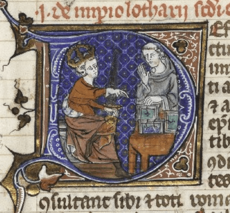
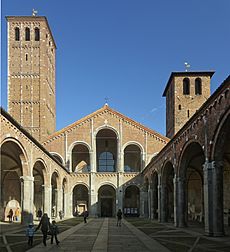
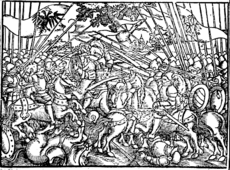
In spring 1106, Henry V thought about his father's mistakes. He realized that ignoring the princes had hurt the empire. So, for the next few years, he shared responsibilities with the princes. He also supported church reforms. Records show that he often acted "with the judgment and advice of the princes." He held many meetings (called Hoftage) to get their agreement.
Many princes attended these meetings. This showed a new sense of responsibility among the king's nobles. Henry V brought back bishops who had been banned by his father. Negotiations with the Pope now included both church leaders and secular princes.
Thanks to this cooperation, Henry V was able to visit all parts of the empire. He could successfully get involved in political matters. He visited Saxony several times until 1112. His relationship with the Saxons was good during these years.
After the Duke of Saxony died in 1106, Henry V gave the Duchy of Saxony to Lothar of Supplinburg. This was a reward for Lothar's support against Henry IV. This decision went against the usual way of passing down titles in families.
Military Actions and Church Conflicts
In 1107, Henry V tried to restore Borivoi II in Bohemia. This was only partly successful. In 1108, he went to war with Coloman of Hungary. An attack by Boleslaus III of Poland forced Henry to stop his campaign. Instead, he invaded Poland. But he was defeated at the Battle of Hundsfeld. In 1110, he successfully secured the Duchy of Bohemia for Ladislaus I.
Imperial rule in Italy had weakened after Henry IV. For 15 years, no emperor had issued documents for the Italian government. This meant Italian officials didn't travel north to get royal documents. In Milan, opposition to the Salian rule grew strong.
Henry V continued to appoint bishops by giving them a ring and a staff. This practice, called "investiture," symbolized the bishop's connection to his church. It had caused the conflict between Henry IV and the Pope. The Pope, Paschal II, demanded that Henry stop this practice completely. But Henry and the bishops continued to work together. Attempts to reach an agreement with the Pope failed in 1106 and 1107.
First Trip to Italy
Seeking a Solution
Henry V's main goal was to solve the Investiture Controversy. This conflict had caused many problems for the empire. The Pope's supporters hoped Henry would agree to the Pope's rules. But the king kept investing bishops. He wanted the Pope to hold a meeting in Germany to settle the issue. The Pope chose France instead. He renewed his ban on lay investiture (non-church leaders appointing bishops). The issue continued until 1110, when negotiations failed again.
In August 1110, Henry V made plans to march to Rome. He wanted to end the investiture dispute honorably. His army took the shortest route through the Great St Bernard Pass. They reached Piacenza and Parma, then Florence. In February 1111, they arrived at Sutri and then moved towards Rome.
Henry felt this trip to Italy was very important. He even ordered a new royal seal. Duke Welf II of Bavaria led a second army group. They entered Italy from the southeast. They met the main army near Roncaglia. This showed that even families who had fought Henry's father were now on his side. Welf's presence was important because he had been married to Matilda of Tuscany. This gave him claims to her large properties in Northern Italy. Matilda allowed the troops to cross her lands.
Henry V sent messengers to Matilda to negotiate peace. Matilda decided to support an agreement between the Pope and the king. This opened the way to Rome for the king.
Henry V put a lot of effort into documenting his trip. He wanted to make sure events looked good for the royal side. He was said to have a huge army of 30,000 knights. This showed his great power. His strong army helped him gain recognition in Lombardy. The archbishop there planned to crown him with the Iron Crown of Lombardy. Henry could only lead such a large army because he had the support of the princes.
Conflict in Rome
Pope Paschal couldn't rely on Matilda of Tuscany for help. He looked for support from the Normans in Southern Italy. The Normans had already occupied Rome against Henry IV in 1084. Roger of Apulia and Robert I of Capua promised to help the Pope if needed. The Pope also got support from Rome's nobles. However, he didn't try to get support in northern Italy. Cities there were starting to resist the emperor.
Henry V still insisted on his right to invest bishops with the ring and staff. He also wanted bishops and abbots to swear loyalty to him. Pope Paschal suggested that Henry give up investiture completely. In return, the church leaders would give back all their lands and rights that came from the king. Henry and Paschal agreed to this idea on February 4, 1111. This meant bishops would lose their political power and wealth. They would become more dependent on the Pope. On February 9, Henry V accepted this agreement, called the Concordat of Sutri.
The coronation ceremonies began on February 12, 1111. Henry V publicly kissed the Pope's feet in front of St. Peter's Basilica. This showed his respect for the Pope. This ritual became a part of future emperor coronations.
Before the coronation, the bishops learned about the agreement. Protests broke out, and there was chaos in the city. The coronation had to be canceled. Henry demanded his investiture rights back and an immediate coronation. Paschal refused. So, Henry seized the Pope and imprisoned him in St. Peter's.
After two months, Henry forced the Pope to agree to the Treaty of Ponte Mammolo on April 12. This agreement gave Henry the right to invest with the ring and staff. On April 13, Paschal crowned Henry emperor. Paschal also had to promise never to excommunicate Henry.
However, by imprisoning the Pope, Henry lost a lot of support. He had captured Christ's representative. As a result, he was banned by a cardinal in Jerusalem in summer 1111. In September 1112, he was excommunicated by a meeting in Burgundy. This was led by Archbishop Guido of Vienne, who later became Pope Calixtus II. Historians see 1111 as a turning point for Henry V. The unity between the church and the king broke. The cooperation between the king and the princes also weakened. In March 1112, the Pope's court canceled the investiture privilege. They called it a "depraved privilege."
Returning to Germany
After the Coronation
After being crowned emperor, Henry quickly went back across the Alps. On his way back, he visited Matilda of Tuscany at Bianello Castle. They made an agreement that historians believe was about Henry V inheriting her property if she died without children.
On August 7, 1111, Henry finally arranged his father's proper funeral. His father had been resting in an unconsecrated chapel. On the same day, and again on August 14, Henry gave two special privileges to the citizens of Speyer. These gave them new civil liberties. This was a "milestone" in the history of civil liberties. The people of Speyer got many rights and benefits. No other city in the empire had such freedoms at that time. These privileges show how the Salian idea of kingship was changing. The king was now granting rights to whole towns, not just the clergy. The city of Worms also received privileges in 1114. However, its citizens did not get the same personal freedoms as Speyer.
Breaking with the Princes

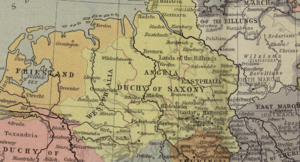
Starting in 1111, Henry began to ignore the princes' opinions. He acted more like his father, ruling on his own. This made conflicts worse. Many church leaders left him. This included Archbishop Conrad I of Salzburg and Bishop Reinhard of Halberstadt. Most importantly, he broke with his long-time friend Adalbert of Saarbrücken. Adalbert had been his imperial chancellor since 1106.
The conflict with Adalbert seemed to be about Trifels Castle. Henry arrested Adalbert and held him for over three years without the princes' consent. The citizens of Mainz had to threaten violence to get Adalbert released in November 1115. Adalbert became a strong opponent of Henry's rule.
Property disputes also caused problems in Saxony. Henry tried to expand his family's lands. In 1112, Lothair of Supplinburg, the Duke of Saxony, rebelled. Henry quickly put down the rebellion. In 1113, after a count died without children, many Saxon nobles claimed his land. But Henry decided the land should go to the empire. This went against Saxon law. Henry got the royal princes to agree, but he didn't talk to the Saxon nobles. Lothair rebelled again. He was defeated but later forgiven.
Archbishop Frederick of Cologne also broke with Henry. This happened during a campaign against the Frisians. The Frisians refused to pay their yearly tax. The citizens of Cologne complained about Henry's harsh officials. Archbishop Frederick said the church was in a terrible state. The bishop seats of Worms and Mainz were empty for years. Royal officials managed the bishops' secular rights.
Battles and Losses
In early 1114, the rebels united behind the Archbishop of Cologne. Two imperial campaigns against them failed. Henry first took the town of Deutz, across the Rhine from Cologne. This allowed him to cut off Cologne's river trade. The citizens of Cologne gathered a large force and crossed the river. They fought Henry's army. The Cologne archers were able to pierce Henry's soldiers' armor. It was summer, and the soldiers had taken off their armor to cool down. Henry retreated. He then attacked Bonn and Jülich.
When he returned to Deutz, he was met by Archbishop Frederick and other nobles. They put up a strong fight. Henry's army was forced back. The defeat at Andernach in October 1114 ended Henry's presence in the Lower Rhine region.
At Christmas 1114, there was more unrest in Saxony. On February 11, 1115, Duke Lothair defeated Henry at the Battle of Welfesholz. This ended Salian rule in Saxony. From then on, Lothair had almost royal power in Saxony. Henry's power to rule the whole empire decreased. Many princes did not attend a meeting in Mainz in November 1115. Henry had to cancel other meetings because not enough people confirmed they would come. Henry celebrated Christmas 1115 in Speyer with only a few loyal followers. Meanwhile, his opponents gathered in Cologne to discuss church issues.
The events of 1111 in Rome and the defeat in 1115 led to a near complete break between the bishops and the king. Under Henry IV, a third of all documents were issued for bishops. Under Henry V, this dropped to only a twelfth.
Henry's position in Bavaria remained strong. He was away from Bavaria from 1111 until 1121. The conflicts in Saxony and the Rhineland required him to be there. But Bavaria stayed loyal. Henry's opponents couldn't gain power there. Bavarian nobles continued to support Henry V. These nobles received special treatment for their loyalty.
Marriage to Matilda of England (1114)
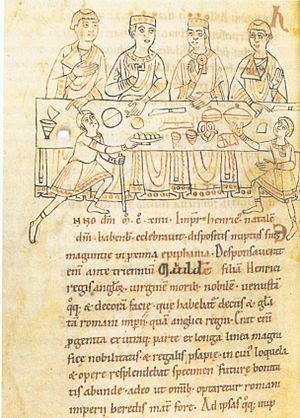
From 1108, Henry V proposed marriage to an English princess. He wanted to increase his authority and secure his throne. His engagement to the eight-year-old princess Matilda took place in Utrecht in 1110. The English King Henry I of England paid a very large sum of silver as a dowry. In return, his daughter's marriage to Henry V greatly increased his prestige.
On July 25, 1110, Matilda was crowned Roman-German Queen in Mainz. Four years later, the wedding celebrations took place in Mainz on January 7, 1114. It was a grand event with princes from all over the empire. The Salians used this occasion to show unity after recent conflicts.
Duke Lothair of Supplinburg appeared barefoot and in penitent clothing at the wedding. He was forgiven for his part in the land disputes after showing his submission. This was the only known time Henry V used such a public act of submission. However, Henry also captured and imprisoned Count Louis of Thuringia for his part in the Saxon rebellion. This upset many princes. Henry's harsh actions spoiled the festive mood. Some princes left the festival without permission. Others used the chance to plot against him.
Henry and Matilda had no sons. A chronicler mentions a child that died soon after birth. One source mentions a daughter named Bertha, who was likely illegitimate. She married Count Ptolemy II of Tusculum in 1117. This marriage connected the emperor to the Roman nobility. This was helpful in his conflict with the Pope.
Henry eventually had to leave Germany for Italy. He appointed Duke Frederick II of Hohenstaufen and his brother Conrad as administrators.
Second Trip to Italy
Securing Inheritance and Power
After Henry left Rome in 1111, a church council declared the right of lay investiture invalid. Guido, Archbishop of Vienne, excommunicated the emperor. He asked the Pope to confirm the ban. But Paschal refused to go that far. The conflict entered a new phase in 1115 when Matilda of Tuscany died.
Matilda's death on July 24, 1115, made Henry travel to Italy in February 1116. He went with only a small group. He wanted to claim his inheritance of her huge properties in Upper and Central Italy. He also wanted to strengthen Salian rule in Northern Italy. This would give him a new power base against his strong opponents in Germany. He issued many documents to show he was a guarantor of law and justice in Italy. Henry got Matilda's property without problems. His authority was accepted in all Italian cities. Henry considered Rome very important. He visited the city five times, more than any other Salian king.
Pope Paschal died on January 21, 1118. Henry helped appoint Archbishop Mauritius of Braga as Pope Gregory VIII. But Gregory couldn't defeat his rival, Pope Gelasius II. Gelasius II himself then banned the emperor.
While Henry was away, the princes in Germany planned to restore peace. They also planned to remove the king if he stayed away too long. Henry quickly ended his Italian trip in fall 1118 and returned north. His wife Matilda stayed in Italy as his deputy. Henry managed to prevent the meeting in Würzburg. His activities until late 1119 are not well known. The lack of royal documents shows that his rule was not very strong.
Ending the Investiture Dispute
The Concordat of Worms
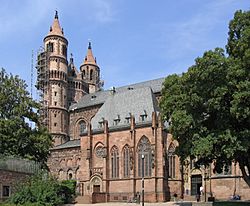
After his second trip to Italy, Henry gradually crushed the opposition in Germany. A general peace was declared at Tribur. The desire to settle the investiture dispute grew stronger.
On February 2, 1119, Pope Calixt II became Pope. On October 24, 1119, the Pope and Emperor again discussed a settlement in Mouzon. Henry wanted to make big commitments only with the princes' consent. The negotiations failed. A meeting in Reims in October 1119 was a turning point. Henry V found it very hard to submit to a reconciliation ritual and meet the Pope barefoot. After his father's walk to Canossa in 1077, such acts of penance felt like subordination to the Pope. It's not certain if this was why the talks failed.
Only after the Concordat of Worms in 1122 was Henry allowed back into the church. He didn't have to do penance or submit. After the negotiations failed, Pope Calixt gave the Archbishop Adalbert of Mainz papal authority. This strengthened the opposition to Henry.
In 1121, the situation became tense again. Henry decided to launch a military campaign against Adalbert of Mainz. The Archbishop gathered large armies, mostly from Saxony, to defend Mainz. As the two armies faced each other, the leading princes began negotiations. In autumn 1121, they urged the emperor to make peace. They wanted him to have balanced policies with the Pope. This action by the princes was important. It showed they were working together to end the conflict.
A peace committee was appointed. It had 12 supporters and 12 opponents of Henry. This committee represented all parts of the empire. The princely assembly met on September 29, 1121, in Würzburg. They forced the emperor to finally make peace with the Pope.
So, on September 23, 1122, the Concordat of Worms was signed. Pope Calixt II was represented by Cardinal Lambert, Bishop of Ostia. The details of the agreement were discussed among the princes. Two documents were exchanged: an imperial one (Heinricianum) and a papal one (Calixtinum). This officially ended the investiture dispute.
For future bishop appointments, there would be a difference between secular property (temporalities) and spiritual authority (spiritualities). Bishops would be chosen by "the clergy and the people." The Heinricianum stated that Henry would stop investing with the ring and staff. The king would restore all church property. He would no longer be the only representative of the empire. He would rule with the princes. The Calixtinum allowed the emperor to be present when bishops and abbots were chosen. Henry could only give the royal symbols (like the scepter) to the newly elected. The final religious ceremony would be done by the Metropolitan for bishops, and by bishops for abbots. Henry, who had been excommunicated, was now welcomed back into the Roman church.
Failed Campaign in France
Henry's marriage to the English royal family got him involved in a conflict in 1123. Henry I of England asked his son-in-law for military help in his fight for power in Normandy. Henry V also wanted to strengthen his position in Flanders. An invasion of Northern France would help him.
In August 1124, Henry V began preparing for a campaign into France. He had very little support from the dukes. This attack sparked a new feeling of patriotism in France. The French King Louis VI used this to gather a huge army. Henry V's forces were no match for them. The campaign was stopped near Metz, and Henry returned home.
Death and What Happened Next
In his last years, the emperor was busy with a campaign in Flanders. He also dealt with the succession of the margraviate of Meissen. In both disputes, his opponents were helped by Lothair of Saxony.
On May 23, 1125, Henry died of cancer in Utrecht. His bones are buried at Speyer Cathedral. His heart and bowels are buried at the Cathedral of Saint Martin, Utrecht. On his deathbed, he asked for his wife Matilda to be cared for. Since he had no legitimate children, he left his possessions to his nephew, Frederick II of Hohenstaufen. With his death, the Salian family line of emperors ended.
Speyer's importance as a burial site for the Salian family declined for a while. It took several generations for it to become a royal burial site again. Henry V had been excommunicated for a long time. This is probably why only a few monasteries continued to remember him in their services.
Matilda gave the imperial symbols to the Archbishop of Mainz. In September 1126, she returned to England. Duke Frederick II of Hohenstaufen was considered a good candidate to be the next king. This was because he was related to Henry V. But he refused to accept a free election by the princes. He was also too confident he would win. This was seen as arrogant. So, his candidacy failed. Other candidates were Leopold III, Margrave of Austria and Charles I, Count of Flanders. Eventually, the Saxon Duke Lothar III was elected. This showed that legitimacy was no longer just about inheritance. It was now about being elected by the imperial princes.
How History Remembers Henry V
Henry V's actions, especially imprisoning the Pope in 1111, changed how people saw him. Arresting an older person was no longer seen as a good way to remove a ruler. Instead, it was seen as a betrayal of his own father. Archbishop Adalbert of Mainz described Henry V's rule as "oppression" of the "church and empire." He said the next "election" should bring "freedom" to the church and "peace" to the people.
French church sources often judged Henry negatively. They called him a troublemaker, a traitor, or a tyrant. For the French abbot Suger of Saint-Denis, Henry was a troublemaker who deserved to die. For Suger, what mattered was how a ruler treated the Pope. Richard of Cluny said Henry's lack of children was fair punishment for betraying his father. Hériman of Tournai said Henry was guilty of "planned betrayal and treachery in Rome." He said Henry "behaved like a tyrant."
The events of 1111 in Rome were talked about all over the Christian world. French records often only mentioned the Pope's imprisonment by Henry. These events even reached far-off places like Brittany. The Chronicon Kemperlegiense mentioned an "emperor" for the first time when recording the Pope's capture. It said, "Emperor Henry came to Rome, captured Paschal by treason and forced him to take an oath."
See also
 In Spanish: Enrique V del Sacro Imperio Romano Germánico para niños
In Spanish: Enrique V del Sacro Imperio Romano Germánico para niños
- Family tree of the German monarchs – he was related to every other king of Germany
Sources
- Kleinhenz, Christopher. Medieval Italy: an encyclopedia, Volume 1. Routledge, 2004.
- Weinfurter, Stefan. Canossa: die Entzauberung der Welt C.H.Beck ISBN: 978-3-406-53590-1. 2006
- Weinfurter, Stefan. "Das Jahrhundert der Salier (1024-1125) Seite 175". Thorbecke Verlag, ISBN: 9783799501408. 2004
- Althoff, Gerd. "Noch einmal zu den Vorwürfen gegen Heinrich IV. Genese, Themen, Einsatzfelder" University of Heidelberg
- Schneidmüller, Bernd; Weinfurter, Stefan. Die deutschen Herrscher des Mittelalters. C.H. Beck. ISBN: 978-3-406-50958-2. 2003
- Lubich, Gerhard. "Heinrich V. in seiner Zeit" (PDF). Regesta
- Stürner, Wolfgang. Die Staufer: Eine mittelalterliche Herrscherdynastie. Kohlhammer Verlag. ISBN: 978-3-17-035365-7. 2019
- Holland, A. W. Germany Adam & Charles Black, pg. 70 1914
- Dendorfer, Jürgen. "Regensburg im »Investiturstreit«". Albert-Ludwigs-Universität Freiburg 2009
- Dendorfer, Jürgen; Struve, Tilman. "Heinrich V. : Könige und Große am Ende der Salierzeit" BÖHLAU VERLAG, KÖLN WEIMAR WIEN 2008
- Dendorfer, Jürgen; Deutinger, Roman. "Das Lehnswesen im Hochmittelalter" (PDF). Jan Thorbecke Verlag
- Dendorfer, Jürgen. "Fidi milites? Die Staufer und Kaiser Heinrich V." ISBN: 978-3799542692 2005
- Robinson, I. S. Henry IV of Germany 1056-1106. Cambridge University Press. pp. 290–. ISBN: 978-0-521-54590-7. 2003
- Bryce, James. The Holy Roman Empire. MacMillan, 1913
- Hartmann, Wilfried. Der Investiturstreit. Oldenbourg Verlag. pp. 3–. ISBN: 978-3-486-70142-5. 2010
- Schlick, Jutta. "König, Fürsten und Reich: (1056 - 1159); Herrschaftsverständnis im Wandel". University of Heidelberg
- Struve, Tilman. "Die Salier, das Reich und der Niederrhein" (PDF). BÖHLAU VERLAG, KÖLN WEIMAR WIEN 2008
- Schutz, Herbert. "The Medieval Empire in Central Europe". Cambridge Scholars Publishing, ISBN: 1443819662 2010
- Halm, Martina. Studien zum Hof Heinrichs V. University of Bonn 2015
- Vickers, Robert. History of Bohemia C.H. Sergel Company, 1894
- Herbers, Klaus; Johrendt, Jochen. Das Papsttum und das vielgestaltige Italien Walter de Gruyter. ISBN: 978-3-11-021468-0 2009
- Borgolte, Michael. Das europäische Mittelalter im Spannungsbogen des Vergleichs. de Gruyter. ISBN: 978-3-05-004829-1. 2009
- Robinson, I. S. The Papacy, 1073-1198: Continuity and Innovation. Cambridge University Press. ISBN: 978-0-521-31922-5. 1990
- Robinson, J.H. Readings in European History: From the breaking up of the Roman empire to the Protestant revolt. Ginn & co (1904)
- Comyn, Robert. History of the Western Empire, from its Restoration by Charlemagne to the Accession of Charles V, Vol. I. 1851
- Gwatkin, H.M., J. P. Whitney The Cambridge Medieval History: Vol III. Cambridge University Press, 1926.
- Norwich, John Julius. The Normans in the South 1016–1130. Longmans: London, 1967.
- Milman, Henry. History of Latin Christianity, including that of the Popes, Vol. III. 1854
|
Henry V, Holy Roman Emperor
Born: 1086 Died: 1125 |
||
| Regnal titles | ||
|---|---|---|
| Preceded by Conrad II |
King of Italy 1098–1125 |
Succeeded by Conrad III |
| German King (formally King of the Romans) 1099–1125 |
Succeeded by Emperor Lothair III |
|
| Preceded by Emperor Henry IV |
King of Arles 1105–1125 |
|
| Holy Roman Emperor 1111–1125 |
||


